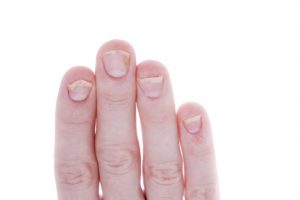
Nail psoriasis, an early sign of psoriatic arthritis
Nail psoriasis can be an early sign of psoriatic arthritis. Previous research has found that at least 80 percent of people with psoriatic arthritis may also have nail psoriasis. A Canadian study looked at 188 people with psoriatic arthritis to determine if these changes to the nails were associated with specific joint symptoms. Of the group, 172 patients had some form of fingernail psoriasis on at least one nail.
Patients with blood spots under the nails known as splinter hemorrhages were found to have a higher number of swollen joints, compared to those with other nail psoriasis symptoms. The type of symptoms a patient had gave insight into what was happening with the joints. Researchers found that those patients with nail crumbling, separation of the nail from the skin under the nail, and a buildup of keratin under the nail were more likely to have a swollen or tender distal interphalangeal (DIP) joint on the same finger. DIP joint is the finger joint closest to the nail.
The researchers suggest that patients with psoriatic arthritis should have their fingernails examined.
Nail psoriasis common changes
Common changes to the nails that occur in nail psoriasis include:
- Pitting of the nails: the nails begin to look like the surface of a thimble
- Onycholysis: the nail becomes detached from the underlying nail bed and a gap develops under the nail
- Subungual hyperkeratosis: chalky substance accumulates underneath the nail and the nail becomes raised and tender when touched
- Discoloration: nail may become a yellowish-brown
- Onychomycosis: a fungal infection that results in thickening of the nail and needs to be treated with antifungals
Nail psoriasis causes and symptoms
Psoriasis tends to run in families with at least 40 percent of psoriasis patients having a first-degree relative with the condition. If both parents have psoriasis, the risk of their child having it increases to 75 percent.
Signs and symptoms of nail psoriasis include:
- Spotted red dots beneath the nail – looks like drops of blood
- Pits in the nail
- Lines going across the nail
- Areas of white on the nail
- Thickening of the skin beneath the nail
- Loosening of the nail
- Crumbling of the nail
- Tiny black lines from the cuticle upwards
- Redness of the pale arched area at the bottom of the nail
- Finger arthritis with nail changes
Nail psoriasis treatment options
Nail psoriasis treatment also involves healthy fingernail care. Here are some tips to maintain healthy nails.
- Keep nails short.
- Protect your nails from damage as best as possible.
- Do not clean debris beneath the nails with sharp objects – try soaking fingernails to loosen up debris.
- Rub moisturizer or oil into cuticles and nail beds.
- Soak your feet for at least 10 minutes in a bowl or bath of warm water to soften the toenails before gently filing the thickened part with an emery board and using good, sharp scissors to trim off small pieces of the nails. Cut toenails straight across to prevent them from growing in.
Medical treatments for nail psoriasis include topical steroid creams for rubbing into the cuticle, steroid injections underneath the nail, removal of the nail, and oral medications. Antifungal medication may be needed as well if a fungus does develop.
How to treat nail psoriasis at home
- Keep nails trimmed and clean.
- Apply aloe vera cream or gel.
- Use antifungal essential oils like tea tree oil.
- Sleep with a humidifier to prevent dry skin.
- Drink plenty of water, avoid processed food, and basically eat a healthy diet, as skin can stay moisturized based on the foods you eat and beverages you drink.
If you have psoriasis, speak to your doctor about your risk of nail psoriasis and have your fingernails checked regularly.